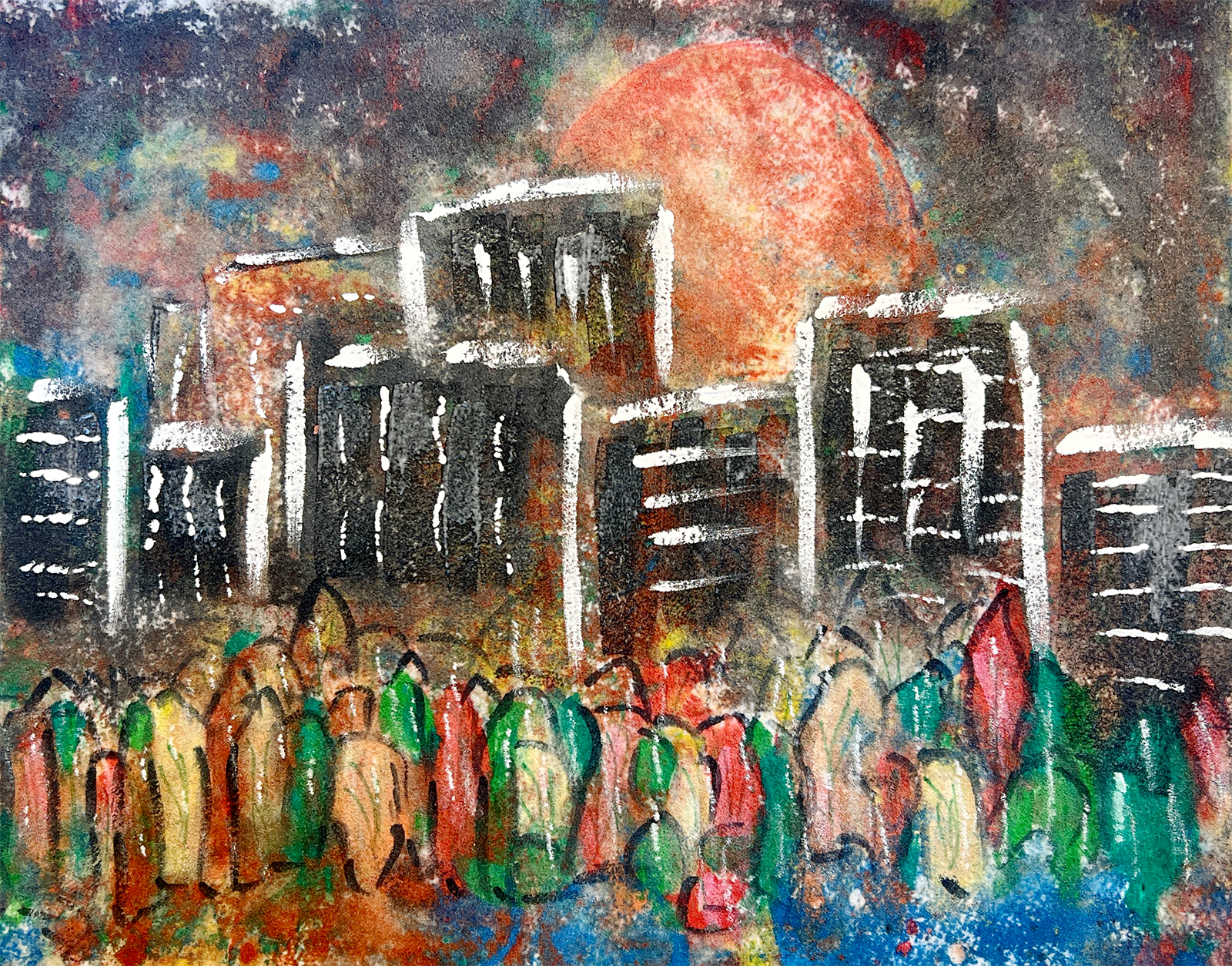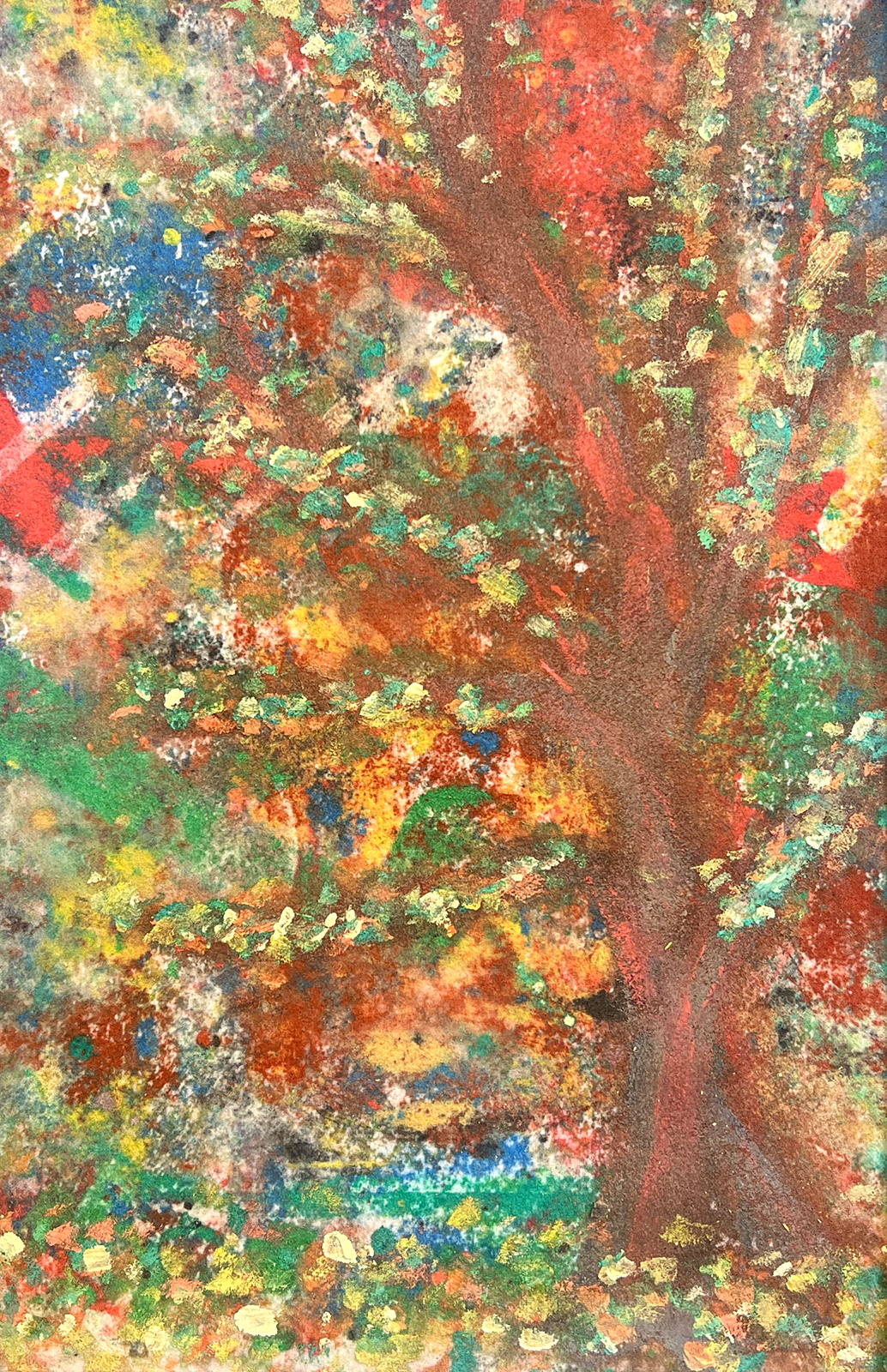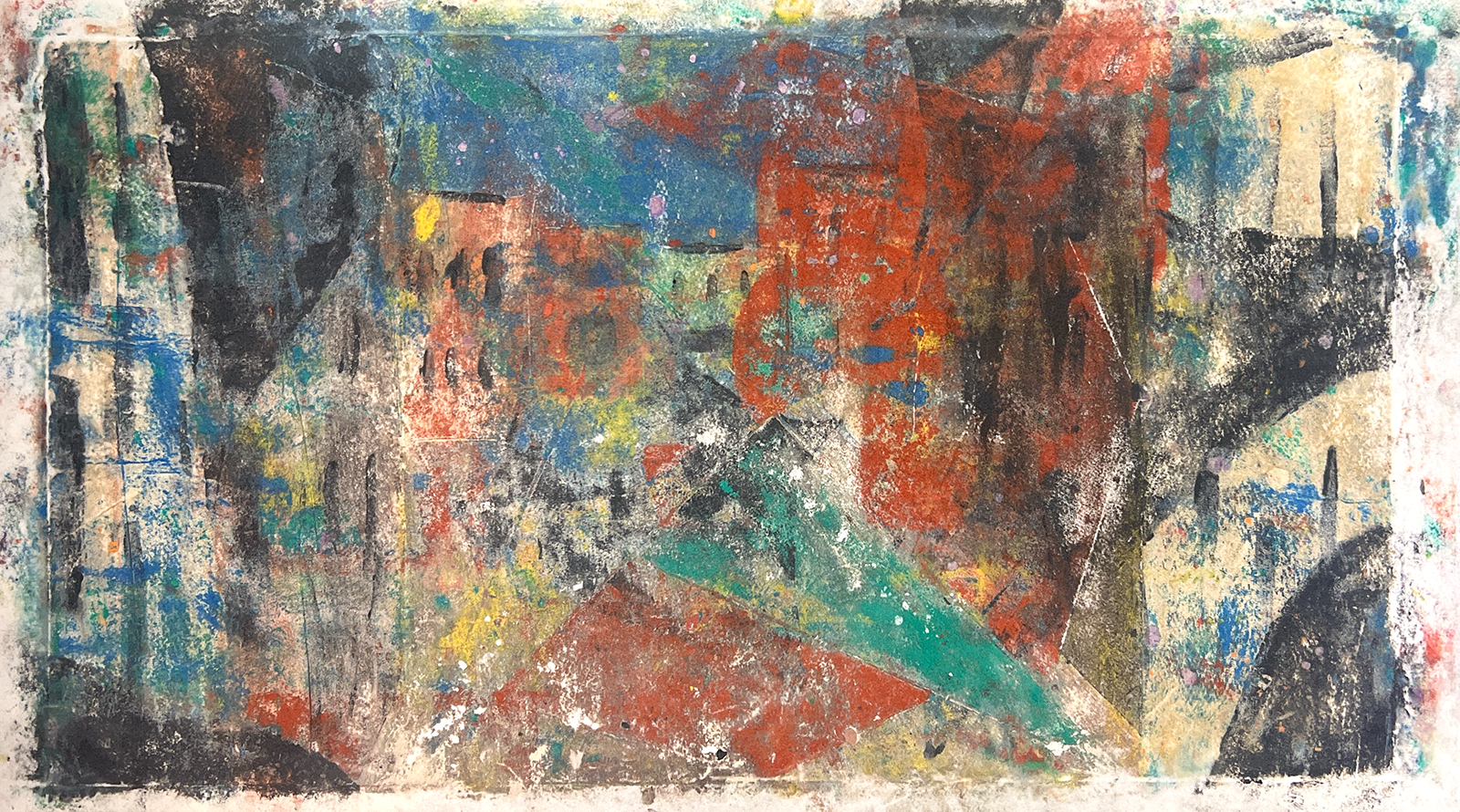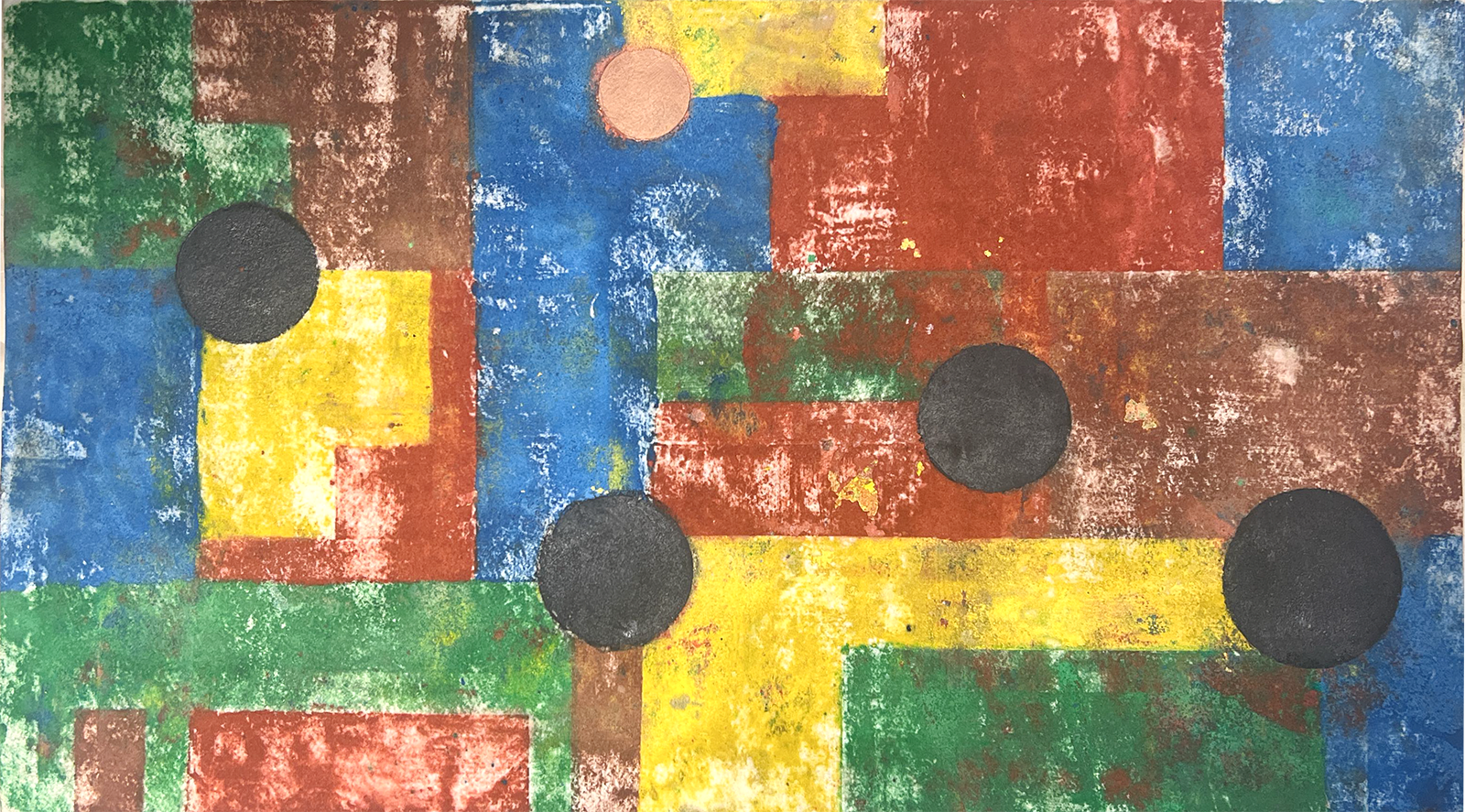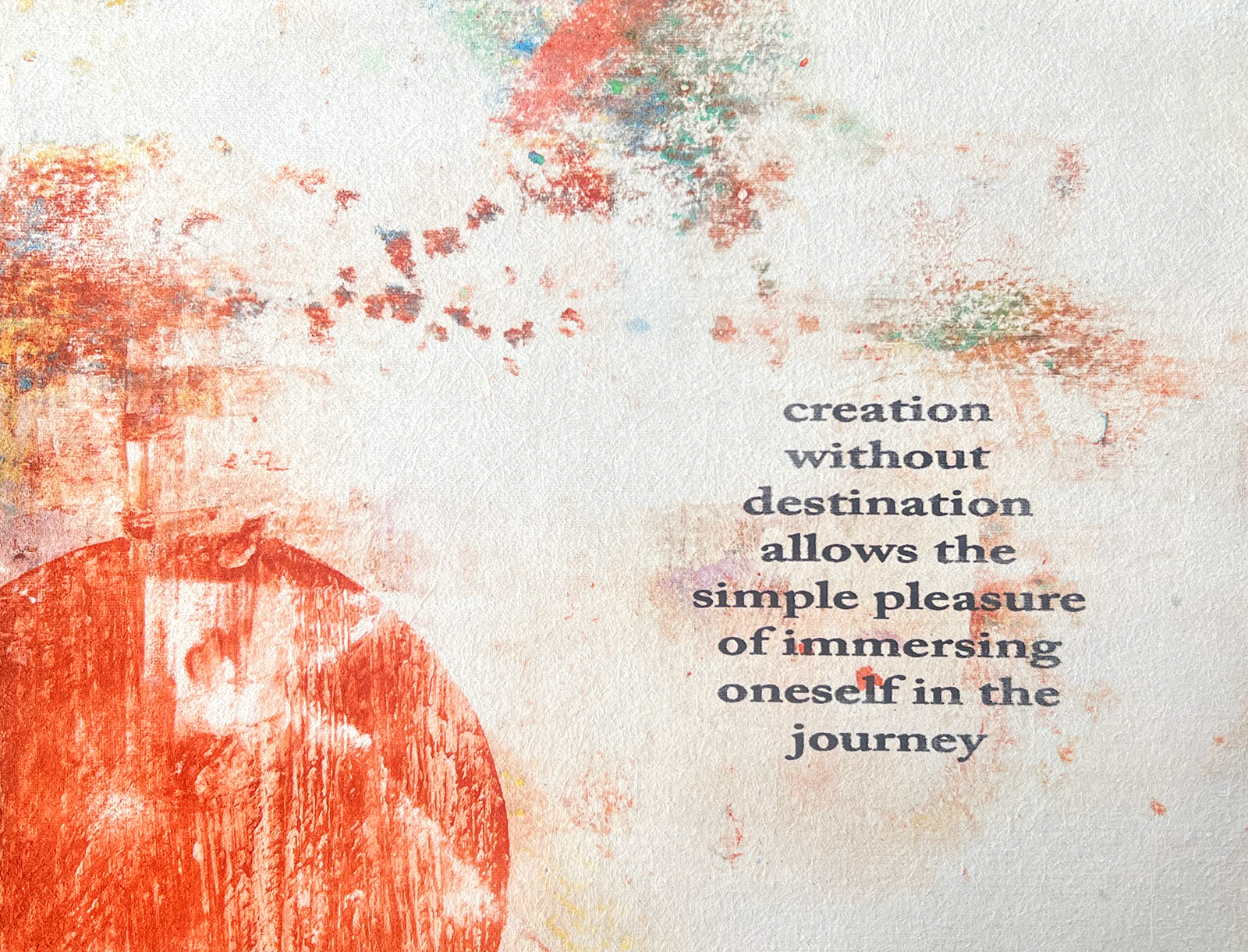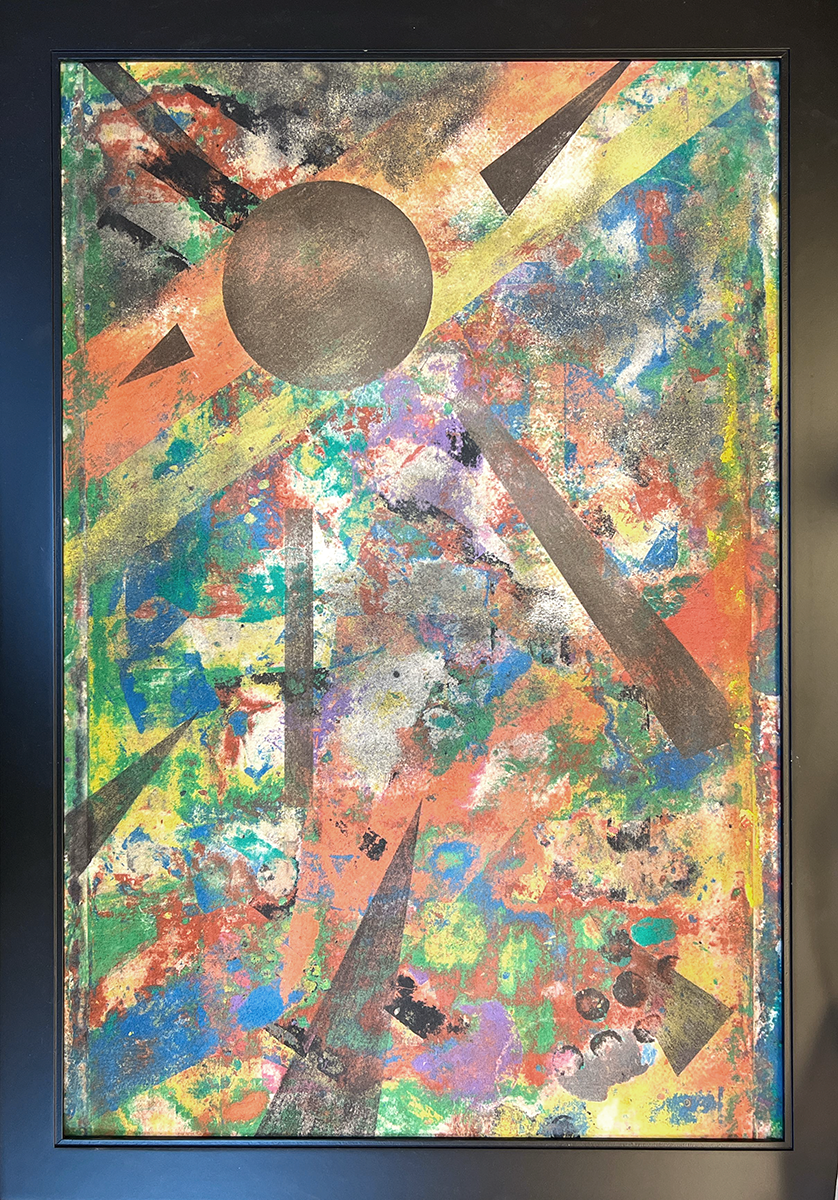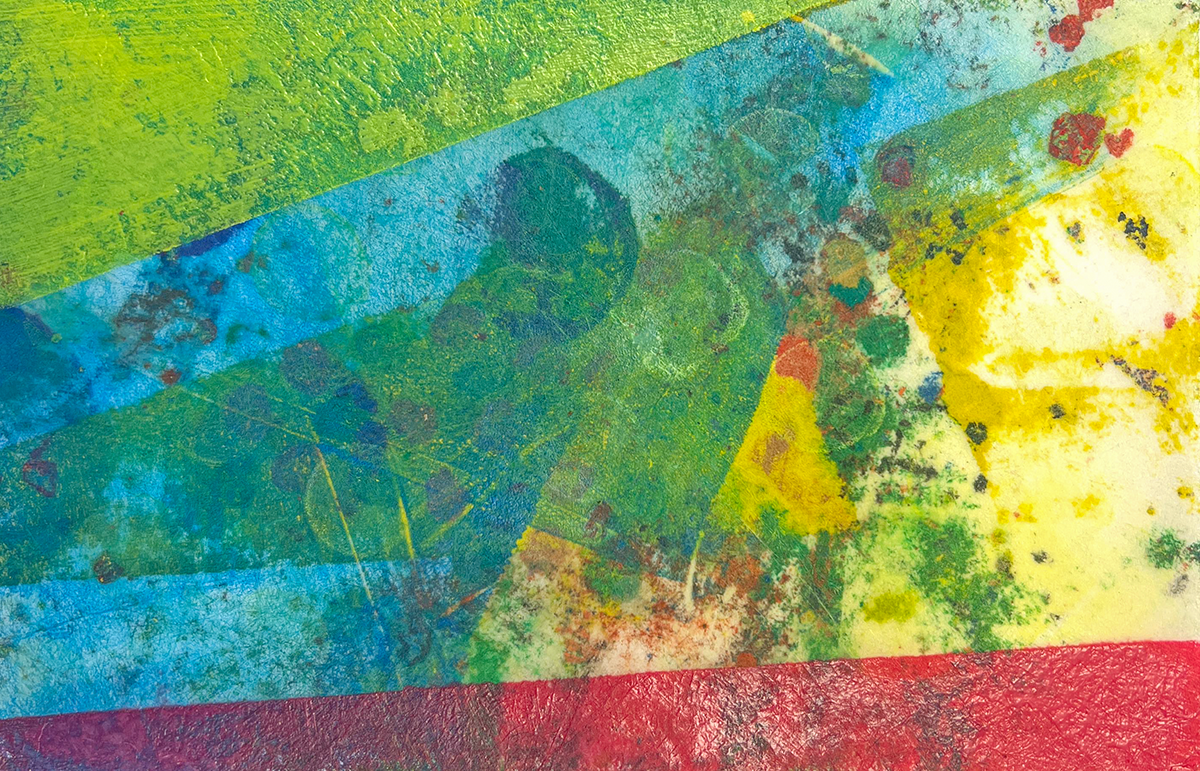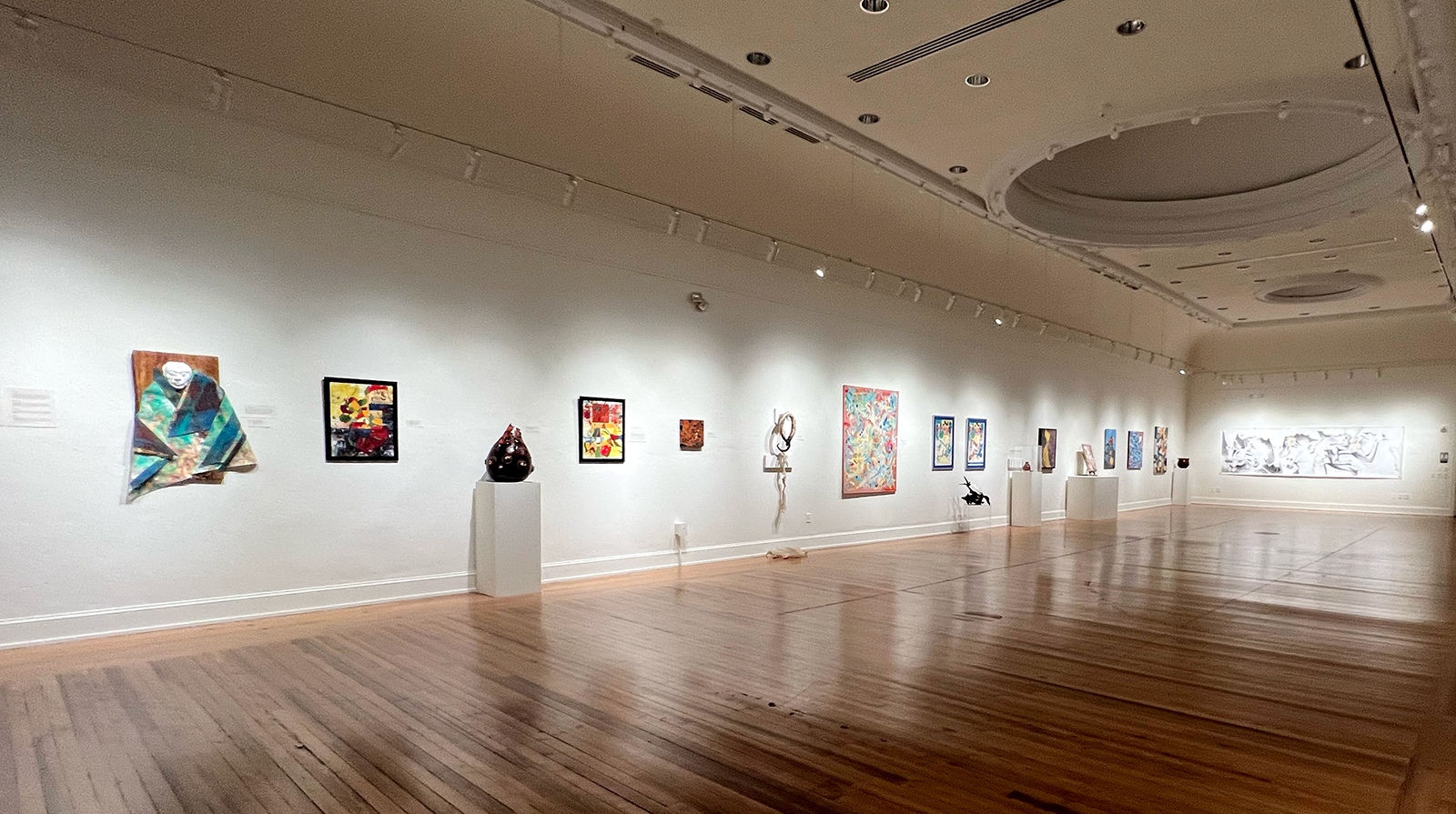Art of the Clay Monoprint
Clay Monoprints are a relatively new art form, but they were formed from the skills of generations of potters and printmakers.
"Renaissance Town II" - Clay Monoprint, Acrylic Paint, Copper Mica, & Calcium Carbonate by Andrew T. Smith
One of my earliest recollections of doing homework was walking by my grandparent’s farm creek with my father to collect clay. We mixed it with hay from the farm and shaped it as an example of adobe (“mudbrick”) bricks. Even today, over half of the world’s citizens live in structures that utilize clay in their construction. We live with and in clay in many different forms.
When the brickmaker, potter, or clay printmaker works with clay, they touch and mold history and ages in the making. Over long stretches of time, rocks (often feldspar, the most abundant mineral group on our planet) are broken down chemically through natural solvents such as carbonic acid. Other clay minerals are formed through processes such as hydrothermal action, moving water under heat, and sometimes via volcanos.
The resting places for the clays are often near slow-moving water areas such as lakes and basins; various amounts of water combine with the clay materials, creating plasticity. When dried naturally or with the addition of heat to speed up the process, water levels decrease, and the clay hardens.
Clay has found essential uses over time, with its properties after drying coming in handy in creating ceramic vessels and both purposeful and decorative items. Human-created pottery shards have origins as far back as 14,000 BC. Ceramic objects found in the Czech Republic date to 29,000-25,000 BC.
Clay slabs were used as our first medium for writing, with a reed-based stylus inscribing the clay. Small balls of clay served as early ammunition. It continues to be used by some for the medicinal treatment of diarrhea.
Many now think of pottery and ceramic uses when hearing the word clay. We know these uses, as stated above, go back thousands of years. Decoration of these objects also started quite early, with paint being added as early as prehistoric times. Early Chinese porcelain included decorative carving, and texture and color were modified by adding sand or metal oxides. These techniques, as well as transferring a design to the pottery or using clay slips (essentially clay with a high moisture content, often with added colorants), continue in the much more recent art form called clay monoprints.
Mitch Lyons had a unique combination of backgrounds that was most likely necessary for introducing the art. His graphics degree and printmaking experience met with his art and ceramic degree.
He noticed that while working on decorating pottery works he created, he could transfer a design he made to the pottery via paper; a small amount of colored clay would stick to the paper and display the design. He rightly surmised that if he experimented with various papers, he might eventually come up with materials that would hold onto enough clay to do an artwork without further transferring it to a clay vessel.
The clay bonds to the paper via an electric charge present in the clay. As such, some materials will “hold on” to the charged clay more than others. While many traditional papers did not attract and hold the clay, Mr. Lyons found some newer man-made materials that did work, including reemay, used in filters, and Pellon, typically used as a fabric interface material.
The clay monoprint artist works on a slab of traditional high-temperature stoneware clay and adds or manipulates additional clay in various forms.
Initial Clay Slab or "Matrix"
The most common addition is through the use of (typically colored) clay slips. A slip is a mixture of clay with additional water, creating a texture between heavy cream and oatmeal in density. (Tile #6) Kaolin or China clay is used. These slips are mixed with universal colorants to create various hues and tones, as the artist wishes.
Clay Slip
Clay Slip with Added Colorant
The artist often starts by "painting" the entirety of the clay, known as the matrix, with one or more shades of colored slip.
From there, numerous techniques are used. A common approach is to paint abstractly on a sheet of blank newsprint with slip, allowing it to dry slightly. This paper can then be placed slip-side down on the matrix, with the clay slip transferred to the matrix via the use of a pastry roller.
Colored slip on Newsprint, Ready to be Transferred via a Pastry Roller
Variations can be used, such as painting specific, concrete shapes on the newsprint, and/or placing a stencil or textured item between the newsprint and matrix before rolling.
One can also paint directly on the matrix, although this can provide a bit too much water content, if the artist is not careful.
Other techniques include:
• placing shaped, pliable, colored clay on the matrix
• sprinkling chips of dried slip on the matrix
• carving into the clay to reveal lower levels of colored slip
• sprinkling common sidewalk chalk or pastels, shaved from a metal mesh strainer, over the matrix
If the artist is using characters like numbers or letters where direction is important, he or she must realize that printmaking reverses the image on the print, so some advanced planning use is necessary.
At times during the process, when water content seems high, or after a good bit of work, a blank sheet of newsprint is placed over the matrix and rolled lightly to reduce moisture and better bind the layers of clay.
When the artist is ready to print, the area for printing is masked with drywall tape, whose adhesive is only light, yet stay in place. The matrix and the receiving material (substrate) are misted lightly with a spray bottle, and the substrate is placed on the matrix.
The pastry roller is worked back and forth over the substrate, particularly working at the edges and corners for a clean transfer of clay. A finishing process occurs by rubbing the bowl of a large spoon over the print, carefully lifting an edge or corner on occasion to check for the quality of transfer.
The completed print is carefully pulled from the matrix and hung to air dry before spraying with a clear water sealant.
The matrix is ready for another print with yet more clay!
Interested in purchasing or commissioning a print? Contact Andy for more information.
Clay Monoprints
by Andrew T. Smith
City's Edge
Due to the relatively short history of clay monoprints as a medium, creating one always feels like an experiment. This is particularly true as I try to see how the prints interact with other mediums.
City’s Edge, ©2024 Andrew T. Smith. Clay Monoprint, Watercolor, Watercolor Pencil, and Acrylic
“City’s Edge”
16” x 20”
Clay Monoprint, Watercolor, Watercolor Pencil, and Acrylic
Andrew Smith / Visual Realia Studio
Due to the relatively short history of clay monoprints as a medium, creating one always feels like an experiment. This is particularly true as I try to see how the prints interact with other mediums.
Clay slip without pigment is an off-white, somewhere between grey and white. Unfortunately, one limitation of clay monoprints is the difficulty in getting a true white or a deep, rich black. I set out to use both via acrylic paints in this work.
To offset the dark city, nature speaks up colorfully in the foreground.
In both instances, the shapes and colors were present in the print, but I sought to emphasize what the monoprint brought. The use of watercolors and watercolor pencils helped with enhancing color. The monoprint, acrylic, and watercolors each bring subtle textural differences, as well.
Most monoprint images I share here are “cropped” to show only what will be visible once framed. In the photo immediately above, I thought it would be instructive to show the entire surface of the print before framing. The edges with less color can be caused by the wooden matrix (clay slab) frame or the taped edge where I intended to end the print. These areas will be trimmed or hidden by the frame.
Copper and Collaboration in the "unentitled" Exhibit at Marketview Arts
Seven artists with unique mediums and techniques exhibit collaborative works in the unentitled exhibit at Market View Arts.
Early during the summer of 2022, several members of the Collective Rogue Arts (CRA), an informal group of area creatives, artists, and entrepreneurs in south-central Pennsylvania, began discussing an exhibit of works focusing on collaborations between two or more artists.
As visual artists, we typically join an exhibit with many predetermined specifics: location, dates, times, exhibit themes, mediums, etc., but in this case, the task was designed from the opposite direction. We opened up this possibility to fellow CRA members.
Seven artists started down the path without a confirmed exhibit location and with only the concept of working on these joint works. During initial meetings, the artists themselves determined the exhibit theme, randomly selected initial collaborative partners for artworks, and a common color (copper) to use on individual 12" x 12" tiles that each would create.
Art is a powerful and valuable tool for looking at social issues, and this exhibit's artists chose to examine challenges around entitlement via their unique mediums, techniques, and place in life. The result is shared with visitors to the gallery space at York's Marketview Arts, part of York College of Pennsylvania's Center for Community Engagement.
In addition to collaborative works, exhibit guests will see individual sample art from each contributor. We hope you join Reagan Bitler, Ophelia Chambliss, Jeannine Dabb, Kristin Kest, Nicole Osborne, Andrew Smith, and Debbie Toluba in considering our continuing role in issues revolving around the challenges for the unentitled.
“The Summoning of Everyman” 2023 © Nicole Osborne & Andrew Smith
The Summoning of Everyman
In the 15th Century play, The Summoning of Everyman, the Everyman character — representing humankind — tries in vain to get others to travel through life's journey by his side. In the end, he learns that he must take this voyage alone.
Some of us are in positions in life that come with supports and inherent systems that aid our journey through life. Others, however, are placed in a tier of those that society has deemed unentitled to companionship, the ability to move forward, and the capacity to discover self-improvement. Their journey is one of disappointment and loneliness.
Artists: Nicole Osborne & Andrew Smith
“Sabotage” 2023 © Kristin Kest & Andrew Smith
Sabotage
Art can be behind obstacles for some: lack of access to meaningful arts experiences is an entrenched part of poverty.
In Sabotage, a work by Kristin Kest and Andrew Smith, gallery visitors are asked to place one or more clay tiles into a smaller display area to represent those with significant barriers to participation in the arts. Adding or removing tiles in the larger central region as they wish, they may note that the systems to create fair, equitable arts access are uneven and broken — sometimes with intent.
“Clay & Play I and Clay & Play II” 2023 © Ophelia Chambliss & Andrew Smith
Clay & Play I and II
The Clay & Play artworks begin with a clay monoprint — clay slip clinging to pellon — which then is transformed with a second layer, this time of acrylic paint guided by a second artist. The top level of play was a series of continuous lines filled with non-contiguous color in the most random yet consistent pattern.
It's way too common in our societies for a less dominant (or unentitled) class to be forced to mold itself onto and into the seams and structures built by the majority or more established group.
Race, gender, age, orientation, and so on are all layers of our larger communities and can be challenging to traverse. Like the art mediums in collaborative art, a prosperous society is best achieved when we celebrate and understand our valued differences and unifying attributes.
Artists: Ophelia Chambliss & Andrew Smith
Medium: Acrylic Paint & Clay Monoprint on Pellon
“Redlined” by Andrew Smith, for the exhibit, unentitled. Copyright ©2023 by Andrew T. Smith.
Redlined
by Andrew Smith
Clay Monoprint, Slip, Copper Mica, LEDs, Copper Wire, Red Tape, Copper Foil, & 9 Volt Battery on Wood Panel
Each of the seven artists created a 12" x 12" tile touching on the shared unentitled theme, utilizing the color of copper to tie the individual artworks together cohesively.
Redlining has had a tremendous negative impact on our communities, the consequences of which can still be seen. In my tile, shown above, a clay monoprint serves as the circuit board, with some areas created with a copper-colored mica in addition to the clay slip. Copper wire is purposely cut heading into the redlined area, removing any potential benefits afforded to the rest of the board.
LEDs are active on the left but are nonfunctional within the redlined area.
unentitled
August 19th - October 21st, 2023
Curator: Ivy Rodgers
Marketview Arts
37 W. Philadelphia St.
York, Pennsylvania
All works copyright the artists and/or Andrew T. Smith
Visual Realia in the "unentitled" Exhibit at Marketview Arts
Andrew Smith of Visual Realia is one of seven artists who created collaborative works on the theme of “unentitled” for this new exhibit in York, Pennsylvania.
The "unentitled" artists discuss the exhibit setup.
Early during the summer of 2022, several members of the Collective Rogue Arts, an informal group of area creatives, artists, and entrepreneurs, began discussing an exhibit of works that were collaborations between two or more artists.
Artists typically join an exhibit with lots of specifics: location, dates, times, exhibit themes, mediums, etc., but in this case, the task was designed from the opposite direction.
Seven of us started down the path without a confirmed exhibit location and with only the concept of working on these joint works. During initial meetings, we determined the exhibit theme, randomly selected initial collaborative partners, and a common color (copper) to use on individual 12" x 12" tiles that each of us would create to work as a whole as a group piece.
Art is a powerful and valuable tool for looking at social issues, and this exhibit's artists chose to discuss challenges around entitlement via their unique mediums and techniques. The result is shared with you in the Marketview Arts gallery space,
Visitors will also see individual sample works from each contributor. We hope you join Reagan Bitler, Ophelia Chambliss, Jeannine Dabb, Kristin Kest, Nicole Osborne, Debbie Toluba, and me in considering our continuing role in issues revolving around the challenges for the unentitled.
unentitled
Marketview Arts
37 W Philadelphia St., York, PA
Opening Reception:
Saturday, August 19th, 2023
5:00 - 7:00 PM
Exhibit:
August 19th - October 21st, 2023
Andy, Teaching, and Clay Monoprints at PechaKucha Night York
Thanks to Enroot, JJ Sheffer, and the York County Economic Alliance, I had the opportunity in May (2023) to be one of five presenters in York, Pennsylvania’s PechaKucha Night York.
Thanks to Enroot, JJ Sheffer, and the York County Economic Alliance, I had the opportunity in May (2023) to be one of five presenters in York, Pennsylvania’s PechaKucha Night York.
For those unfamiliar with the event name, there have been over 1,300 communities that have held similar events with local presenters, but the presentations have some unique twists.
The presenter selects twenty slides, primarily without text, which automatically advance every twenty seconds — regardless of the presenter’s readiness for them to do so! That twist creates the challenge, as well as the puzzle of sorts, in deciding how to tell about your craft in pictures and words in precisely six minutes and forty seconds.
Audience members at the event would see both the presentation on screen and the presenter themselves.
Thanks to JJ for her ongoing work in providing community-building events in York County and to Randy Flaum for his excellent work in capturing the event visually.
YouTube Video of Visual Realia Clay Monoprints
A YouTube video discussing numerous clay monoprints by Andrew Smith of Visual Realia is now available at this link. The prints included are being exhibited throughout 2023 in various locations.
A YouTube video discussing numerous clay monoprints by Andrew Smith of Visual Realia is now available at this link. The prints included are being exhibited throughout 2023 in various locations.



